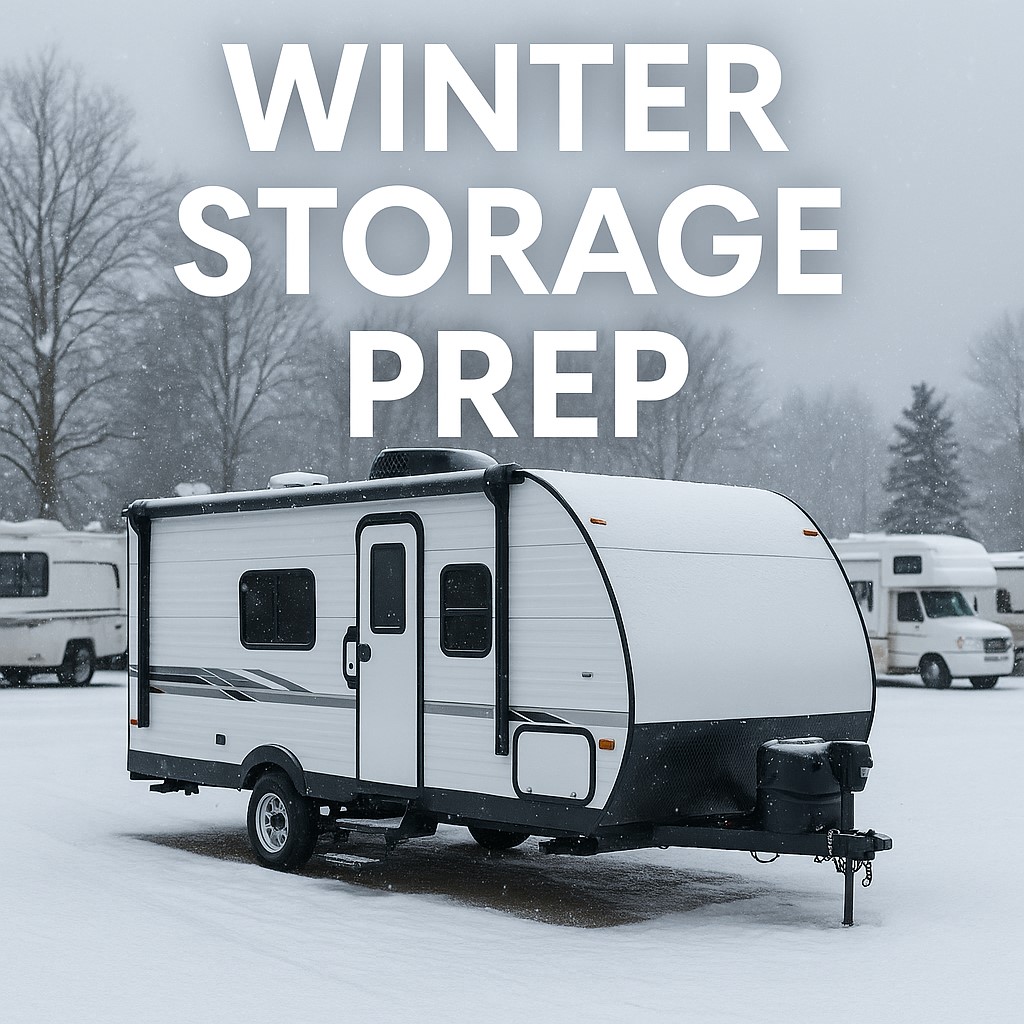 Prepping For Winter Storage
Prepping For Winter Storage
Prepping Your RV for Winter Storage is a crucial process that can save you from expensive repairs come spring. The key is to protect against the three main threats: freezing water, pests, and moisture. Here is a detailed guide on how to properly prepare your RV for winter storage.
1. Prepare the Plumbing and Water Systems
This is the most critical step. Any water left in your pipes, tanks, or appliances can freeze, expand, and cause a burst, leading to costly damage.
- Drain All Tanks: Empty the freshwater, gray, and black water tanks at a dump station.
- Bypass the Water Heater: Locate your water heater’s bypass valve and turn it to the bypass position. This prevents you from having to fill the large tank with antifreeze, saving you money.
- Drain the Water Heater: Make sure the water heater is off and has cooled down. Open the pressure relief valve and remove the drain plug, cap or Anode rod to let all the water out.
- Clear the Lines: You have two options for clearing your water lines:
- Antifreeze Method: Pump non-toxic RV antifreeze (propylene glycol) into the system using a water pump converter kit or an external hand pump. Go to each faucet, turn on both the hot and cold water, and run until you see pink antifreeze come out. Don’t forget the outdoor shower, toilet, and washing machine.
- Air Blow-Out Method: Using a blow-out plug and an air compressor (set to 30-40 PSI), you can force all the water out of the lines. This is a good option if you want to avoid flushing antifreeze from your system in the spring, but you should still pour antifreeze down all P-traps and in the toilet bowl to protect the seals and prevent odors.
2. Clean the Interior and Appliances
When prepping for Winter Storage, the goal here is to remove anything that could attract pests or lead to mold and mildew.
- Deep Clean: Thoroughly clean and vacuum the entire interior. Wipe down all surfaces, paying special attention to the kitchen and bathroom where food crumbs or moisture could be.
- Remove All Food: Take out all food, including dry goods and canned items, as these are a major draw for mice and insects.
- Drain Appliances: Clean out your refrigerator and freezer, and prop their doors open to allow for air circulation and prevent mildew. For a residential-style fridge with a water line, make sure you add antifreeze to protect it.
- Protect from Moisture: Place moisture absorbers, such as desiccants, activated charcoal, or special RV moisture control products, in cupboards and closets to prevent mold and musty odors. Open all cabinet and closet doors to improve air circulation.
- Seal Entry Points: Look for any gaps or holes in the walls, floors, or around pipes and seal them with steel wool or sealant.
3. Protect the Exterior and Tires
Prepping for Winter Storage should also include the outside of your RV. It needs to be protected from the elements to prevent rust, sun damage, and premature wear.
- Wash and Wax: Give your RV a thorough cleaning and waxing to remove dirt and grime and to apply a protective barrier against the elements.
- Cover the Awning: Clean the awning thoroughly, allowing it to dry completely before you roll it back up. This prevents mold and mildew from forming.
- Protect Tires: RV tires can develop “flat spots” and crack during long periods of storage. Inflate your tires to the maximum pressure listed on the sidewall and place tire covers over them to protect against UV rays. For very long-term storage, consider using leveling jacks to take the weight off the tires or place wood blocks underneath them to prevent moisture from the ground.
- Inspect and Seal: Check all seams, windows, and vents for cracks in the sealant or caulking. Re-seal any gaps to prevent water from getting in.
4. Manage the Engine, Battery & Propane
Don’t forget the mechanical and electrical components, as they are often the most costly to repair.
- Manage the Battery: Batteries can freeze and be damaged if left uncharged in cold weather. Fully charge your house and chassis batteries, and then either disconnect them or remove them completely. Store them in a cool, dry place and use a trickle charger or battery maintainer to keep them topped up throughout the winter.
- Add Fuel Stabilizer: For motorhomes, fill the gas tank almost full and add a fuel stabilizer to prevent condensation and fuel degradation. Run the engine for a few minutes to circulate the stabilizer through the fuel lines.
- Check Fluids: Top off all fluids, including engine coolant, transmission fluid, and brake fluid.
- Propane Tanks: Turn off the main valve on your propane tanks. If you plan to store the RV for an extended period, you may want to have your tanks disconnected and removed.
By following the Prepping For Storage steps, you can ensure your RV is protected from the damaging effects of winter and will be ready for your next adventure.
